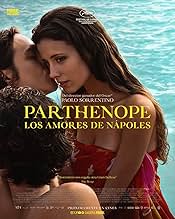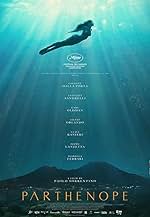- Premios
- 7 premios ganados y 25 nominaciones en total
Antonio Annina
- Raimondo 10 anni
- (as Antonino Annina)
Maria Rosaria Bozzon
- Vecchia megera
- (as Mariarosaria Bozzon)
- Dirección
- Guionista
- Todo el elenco y el equipo
- Producción, taquilla y más en IMDbPro
Resumen
Reviewers say 'Parthenope' by Paolo Sorrentino is visually stunning with breathtaking cinematography and beautiful Naples scenery. It explores themes of beauty, youth, love, and self-discovery. Celeste Dalla Porta's performance is praised for its allure and enigmatic quality. However, the film has mixed reviews, with some finding it pretentious and lacking substance, focusing too much on aesthetics. The narrative structure and character development are contentious, with some appreciating the philosophical approach and others finding it incoherent and shallow.
Opiniones destacadas
I was so close to leaving the cinema half way through this film, but stayed. And the best bits are actually in the 2nd half so Im giving it 6 stars instead of the 4 which the first half deserved. However, I still dont think this is a good movie. Fantastic visually yes, for Sorrentino is a master of unforgettable filmic tableaus, but that just isn't enough.
The overall problem...There is no plot, it's more a series of separate scenes on narcissism, or rather that's how they come across. I think Sorrentino wanted to create something profound but the result feels contrived and sad.
And then there's the anticlimactic ending - a sudden flash forward 50 years to an oddly empty/vacant character that is Parthenope in her 70s. What? Why?
The overall problem...There is no plot, it's more a series of separate scenes on narcissism, or rather that's how they come across. I think Sorrentino wanted to create something profound but the result feels contrived and sad.
And then there's the anticlimactic ending - a sudden flash forward 50 years to an oddly empty/vacant character that is Parthenope in her 70s. What? Why?
The main issue with Parthenope is that it adds nothing new to Paolo Sorrentino's filmography. Too many familiar scenes, too many obsessions already portrayed, too many mannerisms endlessly repeated. While it's true that cigarettes have become a signature of the director, when every actor-from the beautiful lead to the extras in the background-keeps lighting one up, it quickly becomes cloying, if not outright ridiculous. I truly enjoy Sorrentino's cinema, but the excitement I felt leaving the theatre after watching The Consequences of Love is now only a faint memory, faded like the summer youth that once was.
I believe this film has a lot more in common with last year's other hit, The Substance, than you might think. Because in my opinion, Parthenope shouldn't be seen as a human character: she represents Youth itself. Anyone who is attracted to Parthenope is actually attracted to Youth.
"She's always fleeing," says her brother Raimondo, because Youth is a substance that constantly slips through our fingers like sand.
I think there is also an obvious parallel with Aphrodite, who was born from sea foam: Parthenope was born in the water of the Mediterranean Sea.
But nice metaphors, analogies and beautiful cinematography are not enough to touch my soul. For me, this film is only a faint shadow of La grande bellezza. I couldn't help but compare the two films and think that Sorrentino put much more soul into La grande bellezza, because he understands men, but not so much women.
What also disappointed me in this film was the acting of Celeste Dalla Porta and Dario Aita: it's not my cup of tea at all, I found their performance very forced. Although I enjoyed the acting of Luisa Ranieri and Gary Oldman.
Overall, it definitely won't be my favorite Sorrentino film.
"She's always fleeing," says her brother Raimondo, because Youth is a substance that constantly slips through our fingers like sand.
I think there is also an obvious parallel with Aphrodite, who was born from sea foam: Parthenope was born in the water of the Mediterranean Sea.
But nice metaphors, analogies and beautiful cinematography are not enough to touch my soul. For me, this film is only a faint shadow of La grande bellezza. I couldn't help but compare the two films and think that Sorrentino put much more soul into La grande bellezza, because he understands men, but not so much women.
What also disappointed me in this film was the acting of Celeste Dalla Porta and Dario Aita: it's not my cup of tea at all, I found their performance very forced. Although I enjoyed the acting of Luisa Ranieri and Gary Oldman.
Overall, it definitely won't be my favorite Sorrentino film.
Somewhat disappointed by his last film È STATA LA MANO DI DIO, with PARTHENOPE I was reminded of what had touched me so much with the films of Sorrentino. Everything is beautiful, from the city of Naples and its pristine water to the yet unknown goddess Celeste da Porta. Add to it the Fellini-like shots and the wonderful jazz soundtrack by Lele Marchitelli : you get perfection.
The beauty of life in its insignificance... One might think he's making another GRANDE BELLEZZA, but it's just not the case. Sorrentino manages to surprise us once again, with a new way of dealing with what is - ultimately - the same topic.
The movie asks questions without ever answering them, as if to say that one should just stop looking for answers and start observing the beauty of the world for what it is. As a result, the spectator leaves the theater not with answers, but with an interesting take on life, and ultimately death...
Oh, and I almost forgot, the movie stars Gary Oldman. Though his onscreen time is limited, he manages to pull out a wonderful performance. He then withdraws, as if he were urging us to enjoy the movie he convinced us (by his presence in the cast) to go watch.
So I know not everybody is going to like it - some scenes are pretty weird I have to admit - but as far is I'm concerned, this movie gave me everything I did (and didn't) expect when stepping into the theater. Sincerely hope/think it will win Palme d'Or.
Grazie Paolo ;)
The beauty of life in its insignificance... One might think he's making another GRANDE BELLEZZA, but it's just not the case. Sorrentino manages to surprise us once again, with a new way of dealing with what is - ultimately - the same topic.
The movie asks questions without ever answering them, as if to say that one should just stop looking for answers and start observing the beauty of the world for what it is. As a result, the spectator leaves the theater not with answers, but with an interesting take on life, and ultimately death...
Oh, and I almost forgot, the movie stars Gary Oldman. Though his onscreen time is limited, he manages to pull out a wonderful performance. He then withdraws, as if he were urging us to enjoy the movie he convinced us (by his presence in the cast) to go watch.
So I know not everybody is going to like it - some scenes are pretty weird I have to admit - but as far is I'm concerned, this movie gave me everything I did (and didn't) expect when stepping into the theater. Sincerely hope/think it will win Palme d'Or.
Grazie Paolo ;)
Why would you watch this movie? Probably based on what we know that is said about Sorrentino and his perfect eye for the breathtaking visuals. Indeed, with the first shot in the movie he makes it clear - showing a carriage and the "Captain" floating on the sea with the view on the stunning coast of Napoli!
Not its beauty, but the Napoli itself is one of the key topics. If this city could be personified, it will definitely be a beautiful woman. Only, just like a person, Napoli is much more than a beauty and it definitely has its dark places.
It personally touched me that one of the key topics (and a key question) is also (what is) a study of Anthropology. Anthropology, formed of two Latin words, meaning a person and science. No other study could have been better for this movie, rather than a study of the most complicated being in this world. I will save you from spoilers and let you think of what Anthropology is before the movie answers it for you, but keep in mind that it is shown by the biggest "superpowers" of Parthenope and especially in her brother Raimondo, who in my opinion was the one that taught that to Parthenope.
The third matter that made me absolutely passionate about this movie was the precise choice of words and creation of dialogues. Her love interests were mostly people who had the most beautiful way of expressing their emotions. Listing to their dialogues made me feel like I've read a book.
I highly recommend watching this movie, although it may have some bizarre moments that can make you feel uneasy. But if you are open to understanding and accepting the strangeness, it will definitely let you "get carried away."
Not its beauty, but the Napoli itself is one of the key topics. If this city could be personified, it will definitely be a beautiful woman. Only, just like a person, Napoli is much more than a beauty and it definitely has its dark places.
It personally touched me that one of the key topics (and a key question) is also (what is) a study of Anthropology. Anthropology, formed of two Latin words, meaning a person and science. No other study could have been better for this movie, rather than a study of the most complicated being in this world. I will save you from spoilers and let you think of what Anthropology is before the movie answers it for you, but keep in mind that it is shown by the biggest "superpowers" of Parthenope and especially in her brother Raimondo, who in my opinion was the one that taught that to Parthenope.
The third matter that made me absolutely passionate about this movie was the precise choice of words and creation of dialogues. Her love interests were mostly people who had the most beautiful way of expressing their emotions. Listing to their dialogues made me feel like I've read a book.
I highly recommend watching this movie, although it may have some bizarre moments that can make you feel uneasy. But if you are open to understanding and accepting the strangeness, it will definitely let you "get carried away."
¿Sabías que…?
- TriviaPaolo Sorrentino said he reached out to Gary Oldman about filming a cameo after hearing that Oldman was a huge fan of his. Oldman immediately accepted saying Sorrentino was at the top of his wish list to collaborate with.
- Citas
Devoto Marotta: It's very difficult to see, because it's the last thing you learn.
Parthenope: When do you learn to see?
Devoto Marotta: When everything else begins to be missing.
Parthenope: What is everything else?
Devoto Marotta: Love, youth, desire, emotion, pleasure.
- Bandas sonorasWarmth
Written by Peter Gregson
Performed by Peter Gregson, Warren Zielinski, Magdalena Filipczak, Laurie Anderson, Ashok Klouda
Selecciones populares
Inicia sesión para calificar y agrega a la lista de videos para obtener recomendaciones personalizadas
- How long is Parthenope?Con tecnología de Alexa
Detalles
- Fecha de lanzamiento
- Países de origen
- Sitios oficiales
- Idiomas
- También se conoce como
- Партенопа
- Locaciones de filmación
- Productoras
- Ver más créditos de la compañía en IMDbPro
Taquilla
- Presupuesto
- EUR 26,300,000 (estimado)
- Total en EE. UU. y Canadá
- USD 289,303
- Fin de semana de estreno en EE. UU. y Canadá
- USD 31,588
- 9 feb 2025
- Total a nivel mundial
- USD 11,651,125
- Tiempo de ejecución2 horas 17 minutos
- Color
- Mezcla de sonido
- Relación de aspecto
- 2.39 : 1
Contribuir a esta página
Sugiere una edición o agrega el contenido que falta





























